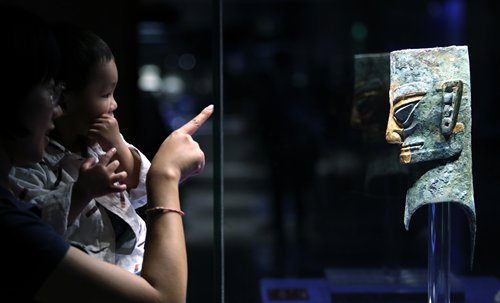TRAVEL / EVENTS
Chinese magazine publishes list of the top 10 representative archaeological discoveries made since PRC’s founding
Treasures of a civilization

Visitors look at a Sanxingdui bronze head with gold foil mask at the Sanxingdui Museum in Guanghan, Sichuan Province. Photo:IC
National Humanity History, a Chinese semimonthly magazine that provides information on politics, history and the humanities, published a list in its July issue of the top 10 representative archaeological discoveries made since the founding of the People's Republic of China in 1949.As a nation with a long history that dates back 5,000 years, China boasts numerous heritage sites. When the Archaeological Ruins of Liangzhu City was inscribed to the UNESCO World Heritage List on July 6, the total number of World Heritage sites in China reached 55, the highest in the world alongside with Italy. Moreover, there are many more significant archeological findings that have yet to or are still waiting on their application to UNESCO.
Of the 10 sites on the recently published list, The Archaeological Ruins of Liangzhu City and Mausoleum of the First Qin Emperor are two relatively well-known discoveries due to their statuses as World Heritage sites. The rest, however, may not be as well-known but are equally important and may one day be selected for the World Heritage list.
Two of these are outlined elow.
Sanxingdui Ruins
The Sanxingdui Ruins were actually something of an accidental discovery. However, this doesn't lessen their importance as they have provided important evidence of the existence of a distinctive ancient civilization in Southwest China's Sichuan Province.
The eventual discovery of the ruins began with two farmers unearthing jade artifacts while working on their farm in Guanghan, Southwest China's Sichuan Province in 1929. The jades eventually made their way to antique markets and they later captured the interest of scholars who were curious about their archaeological value. The first people to explore the area where they were discovered were missionaries and foreign professors, but their research was interrupted by rampant robberies and the unstable social environment of the time.
In 1953, an archaeological team was dispatched by the government to explore the site. Over the following decades, new discoveries were constantly made. The discovery of Sacrificial Pits No.1 and No.2 were major breakthroughs from which archaeologists unearthed 1,620 burial objects including bronzes, jades and tusks of ivory. The two sacrificial pits are only around 18 cubic meters in size, but the findings could fill a small-scale museum.
The vast number and exquisite craftsmanship of the unearthed objects suggest that the Sanxingdui Ruins may have once been part of a major city in the ancient Shu Kingdom that existed 3,000 years ago. The discovery proves that the Yangtze River region was as crucial as the Yellow River when it comes to the cultural roots of Chinese.
The objects are very distinctive from those found in the central plains of China. The bronze wares are particularly large in size and feature very different styles. The unearthed gold artifacts prove that the Shu Kingdom possessed gold craftsmanship that was superior to the central plains. For example, three giant bronze statues with human faces have ears that look like flying birds and eyes that pop out on stalks similar to a crab.
Haihunhou Tomb
The Haihunhou (Marquis of Haihun) Tomb in Nanchang, East China's Jiangxi Province, is the burial place of the royal prince Liu He of the Han Dynasty (206BC-220), who was emperor for just 27 days before he was deposed.
Since the number of treasures reflected one's social statues during the Han Dynasty, the tombs of nobility during that period were appealing targets for grave robbers. Evidence indicates that the Haihunhou Tomb had been broken into several times since the Five Dynasties period (907-960). Oddly enough, it was due to a tomb robbery in 2011 that it was rediscovered in modern times.
The tomb has seen many hardships over the years. An earthquake during the Eastern Jin (317-420) filled it with earth while flooding during the Southern Dynasties (420-589) caused the earth to turn to mud, which in turn froze the funerary objects in place after it dried. This created difficulties for tomb robbers but also for archaeologists.
The Haihunhou Tomb is the first tomb to be discovered south of the Yangtze River in which real horse carriages were used as funerary objects. The gold artifacts found in this tomb alone outnumber the total number of gold wares unearthed in all other Han Dynasty tombs in China.
Thanks to advancements in technology, archaeologists came up with some creative methods to protect the cultural relics in the tomb during an excavation. For example, they moved an entire coffin into a low oxygen laboratory to avoid the oxidation of the silk clothing inside.
The remaining representative archaeological findings are:
The Taosi Ruins
The Erlitou Ruins
The Fuhao Tomb
The Zenghouyi Tomb
The Manchen Han Tomb
The Famen Temple
